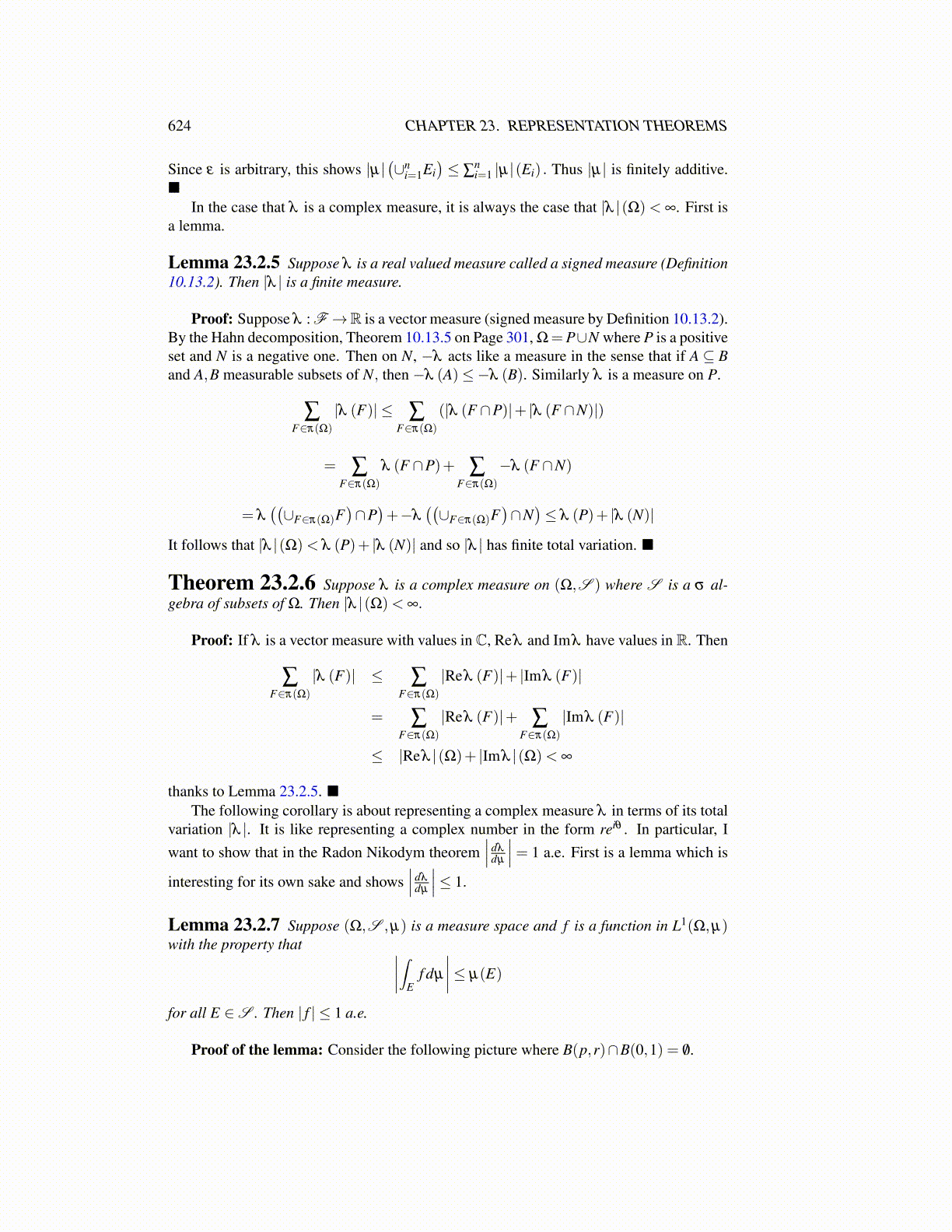
624 CHAPTER 23. REPRESENTATION THEOREMS
Since ε is arbitrary, this shows |µ|(∪n
i=1Ei)≤ ∑
ni=1 |µ|(Ei) . Thus |µ| is finitely additive.
■In the case that λ is a complex measure, it is always the case that |λ |(Ω)< ∞. First is
a lemma.
Lemma 23.2.5 Suppose λ is a real valued measure called a signed measure (Definition10.13.2). Then |λ | is a finite measure.
Proof: Suppose λ : F →R is a vector measure (signed measure by Definition 10.13.2).By the Hahn decomposition, Theorem 10.13.5 on Page 301, Ω=P∪N where P is a positiveset and N is a negative one. Then on N, −λ acts like a measure in the sense that if A ⊆ Band A,B measurable subsets of N, then −λ (A)≤−λ (B). Similarly λ is a measure on P.
∑F∈π(Ω)
|λ (F)| ≤ ∑F∈π(Ω)
(|λ (F ∩P)|+ |λ (F ∩N)|)
= ∑F∈π(Ω)
λ (F ∩P)+ ∑F∈π(Ω)
−λ (F ∩N)
= λ((∪F∈π(Ω)F
)∩P)+−λ
((∪F∈π(Ω)F
)∩N)≤ λ (P)+ |λ (N)|
It follows that |λ |(Ω)< λ (P)+ |λ (N)| and so |λ | has finite total variation. ■
Theorem 23.2.6 Suppose λ is a complex measure on (Ω,S ) where S is a σ al-gebra of subsets of Ω. Then |λ |(Ω)< ∞.
Proof: If λ is a vector measure with values in C, Reλ and Imλ have values in R. Then
∑F∈π(Ω)
|λ (F)| ≤ ∑F∈π(Ω)
|Reλ (F)|+ |Imλ (F)|
= ∑F∈π(Ω)
|Reλ (F)|+ ∑F∈π(Ω)
|Imλ (F)|
≤ |Reλ |(Ω)+ |Imλ |(Ω)< ∞
thanks to Lemma 23.2.5. ■The following corollary is about representing a complex measure λ in terms of its total
variation |λ |. It is like representing a complex number in the form reiθ . In particular, Iwant to show that in the Radon Nikodym theorem
∣∣∣ dλ
dµ
∣∣∣ = 1 a.e. First is a lemma which is
interesting for its own sake and shows∣∣∣ dλ
dµ
∣∣∣≤ 1.
Lemma 23.2.7 Suppose (Ω,S ,µ) is a measure space and f is a function in L1(Ω,µ)with the property that ∣∣∣∣∫E
f dµ
∣∣∣∣≤ µ(E)
for all E ∈S . Then | f | ≤ 1 a.e.
Proof of the lemma: Consider the following picture where B(p,r)∩B(0,1) = /0.